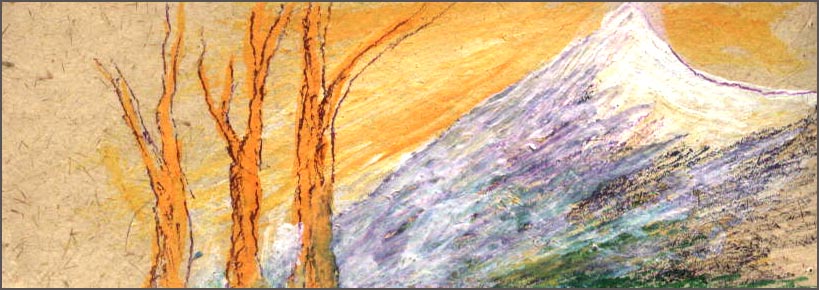

THE IMPACT OF BUDDHIST SCULPTURE AND PAINTING ON ANDHRA Dr.Sanjiva Dev |
eyes, the lotus-face, the lotus-seat etc., are common words we use in our everyday life. Lotus is a symbol of transformation of the low into the lofty, for the lotus is born in mud in the bottom of a lake and the flowers reaches the surface of the clear blue water under the resplendent blue sky in the bright sunlight. It takes birth in the low surroundings and yet culminates into high and enchanting surroundings. Consequently, the lotus is a veritable symbol of the transformation of the low into the lofty. In the same way, Buddhism too is a religion of transformation of the low into the lofty. Buddhism cares for the low, for the fallen, for the distressed, for the insignificant and endeavours to transform them into what they originally were not. Thus the lotus and Buddhism are analogous in their nature and ideals; that was why the Buddhism is a called Saddharma Pundarika’ or The White lotus of Righteousness. So, it was in the fitness of things when the Hinayana sculptors at Amaravati depicted the birth of Buddha as a lotus plant emerging out of a vessel. The next significant event in Buddha’s life was Maha Sambodhi or the Great Enlightenment, which he attained under the Bodhi tree and so the Bodhi tree symbolizes the Enlightenment. Hence the sculptors sculpted the scene in the form of a Bodhi tree under which were shown a throne and the impressions of feet; the throne was shown in order to indicate that Buddha was not an ordinary Enlightened One but a Royal Enlightened one. The third scene from Buddha’s life was the First Sermon delivered at lssipatna or the modern Sarnath. The First Sermon was called Dharma Chakra Pravartana or Dhamma Chakka Pavattana in Prakrit. Buddha uttered these words while he was |
bound for Kase “Dhamma Chakka Pavattetum Gacchami Kasinam Puram” I am proceeding to the city of Kasi for the Revolution of Righteousness. Dharma or righteousness resembles a wheel; the wheel has neither a beginning nor an end and thus it is infinite and the same truth does equally apply to Dharma as it is beyond all beginning and end. Hence the wheel is the best symbol of Dharma and accordingly the Hinayana sculptors at Amaravati did carve the form of a wheel on a pillar. Eventually, the fourth scene in Buddha’s life was Maha Parinirvana or death. Stupa represents a tomb and tomb is associated with death and hence Stupa is a symbol of death. The sculptors, thus, depicted the death in the form of a Stupa in the presence of some votaries in this way, the Hinayana sculptors at Amaravati were both wise and deft enough to illustrate a the life of Buddha, in stone, without showing the image of Buddha. It was the virtue of symbolisation ! With the advent of the Mahayana sect in the second century A.D. the Mahayana sculptors started creating the images of Buddha. If it was true that no portrait of Buddha was done either in the days when Buddha was alive or in the days after his death, how could the Mahayana sculptors make the portraits of Buddha? On what prototype did they rely for executing the portrait-sculptures of Buddha? In the absence of such a prototype of the resemblance of Buddha the Mahayana portraitists literary sources in which the form of Buddha was depicted in words instead of form of Buddha was depicted in words instead of form or line and colour. Otherwise, the sculptors had to give form, in stone, to their own figments. However, this problem was destined to be solved by the sculptor who happened to sculpt the very first image of |
Buddha. Subsequent sculptors had the facility as well as the felicity of relying upon the prototype wrought by the first sculptor. We need not bother about the authenticity of the portrait of Buddha, for the authenticity of the very existence of Buddha is doubted by several scholars, of late! Even the authenticity of history itself is being doubted by many! It is believed, the first images of Buddha were produced at Gandhara and Mathura. Later, the sculptors of Amaravati used to create the images of Buddha in the foot-prints of their precursors. The very name of Buddhists sculpture reminds the art-lovers, of the splendour of the Amaravati sculptures. Sculpture, in general, is of tow types the round sculpture and the relief. Round sculpture contains no background whereas the relief sculpture has background. In general, round sculpture is made when there is to be shown a single figure while the relief is done to show a group composition. In one sense, a relief is a sort of tactile and elevated painting. Relief sculpture is again of two types, high-relief and low-relief or bas-relief Indian sculpture of Amaravati, is to a greater extent, relief sculpture, albeit there is no dearth of round sculpture. Round sculpture could be seen from the back side too which implies that one could see even the back of the figure, which is impossible in the case of relief sculpture. In the relief sculpture the faces of the figures alone are visible and not their backs which conceal themselves in the background on which they exist. In a figurestudy. Whether graphic or glyptic, what is significant part of the body, the face, is visible from the front. The origin of the bas-relief or low-relief goes to the ivory carving of yore, especially practiced in Vidisha.The relief aculptures of Amaravati are indeed delectable poems in stones. |